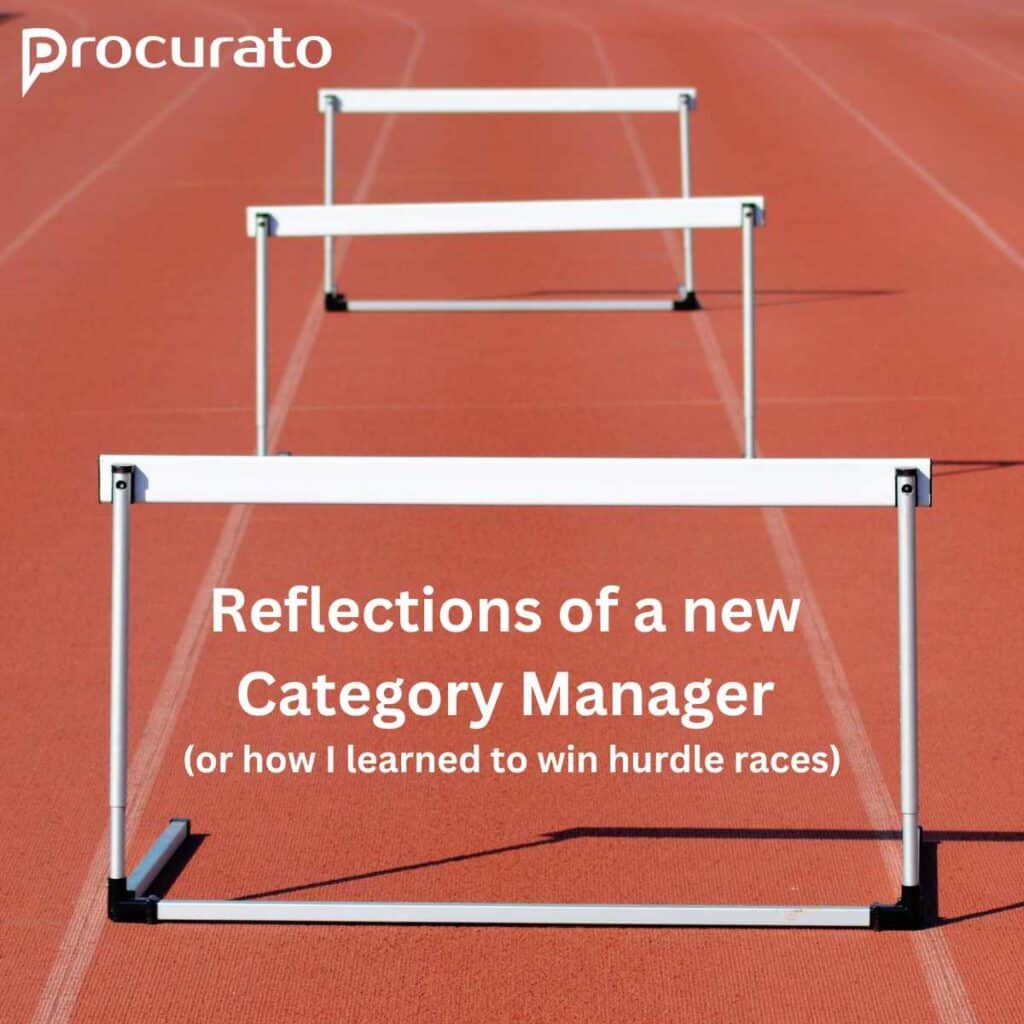
“Out of clutter, find simplicity.” ― Albert Einstein
Category management and hurdle races, what do they have in common? Everything. Overcoming hurdles is what I do every day and at every strategic bend of my journey as a category manager.
When I first started in category management, having done the initial research of my indirect categories (Human Resources, Facilities and Marketing), I was awed by the seeming wealth of possibilities. Ambitious and full of enthusiasm, I wanted to change the world.
In the world of procurement as I knew it, suddenly everything became about “strategy” and “being strategic”; in my first few months as a Category Manager, I was intoxicated by the word… until I realised it was more often than not a pretty façade with no building behind it. What I found in practice was that category management was a lot of the time anything but strategic.
While category management offers numerous benefits when a strategic approach is genuinely applied – the right products are bought at the right price, added value is created, opportunities are spotted early, taken up and acted upon, consolidation is achieved, and savings are made. However, it is seldom smooth, straightforward and easy. Enthusiastic about all the strategic planning and refinement we could do as a team, I initiated conversations with the key stakeholders, starting with my own procurement team. The head of procurement and my line manager, who had been with the company for over twenty years, approvingly patted me on the back and laughed. Little did I know just how many hurdles I would encounter before I could even plot the first moves executing my strategic category plan.
I was soon to discover how bad our data was and how much this one issue would block my path. What data was available was highly inaccurate and patchy. Which, as I found later through experience managing categories across the different industries, was a common issue: a lot of organizations often struggle with incomplete, inconsistent and outdated data. How can you build good insights and decisions when your data is unreliable? Where does it send your strategy if your categories are highly complex and your supplier base extensive and diverse?
And then the next obvious issue presented itself: the lack of internal alignment and early involvement, meaning options were being closed before procurement got involved in the sourcing process. My expectations and strategy were not always the same as my key stakeholders’. We all had conflicting objectives and different priorities, and cross-functional work sounded like another beautiful construct that only existed on paper and was really a joke. How can you get people interested in long-term strategy when all they are focused on is short-term goals and quick wins? The internal resistance to change was astounding and, as it turned out, the hardest of my hurdles to get over.
I was lost. Finding simplicity out of all this clutter sounded impossible. Jumping over the barriers that were erected invisibly but consistently was initially like tilting at windmills. However, my enthusiasm was there and I knew that, just like an athlete in a hurdle race, with effort, focus and training, I could still successfully get over the obstacles and finish the race.
Supplier relationship management served as a powerful lever. Although there was a lack of visibility and insufficient alignment initially, there was willingness to co-operate, improve and share information. There was a clear joint advantage in improving the data quality and visibility. More generally, establishing a collaborative approach and managing the relationships with the key suppliers more closely improved communication, saved a lot of time and made problem-solving simpler and much more efficient. It also brought additional benefits such as reduced costs and risk. The improved information visibility and knowledge sharing in turn helped create and sustain a truly partnership-style relationship.
I took a similar collaborative approach to the cross-functional work. The initial resistance was no small hurdle to overcome but I knew that sometimes, just like in a steeplechase, you need to jump without really knowing what is on the other side. Using my ability to deal with the tough issues and not to give up, with the growing support of my own team I managed to obtain the cross-functional buy-in. Then slowly but steadily came the sharing of ideas and our different perspectives, helping each other when dealing with our separate day-to-day issues and sharing of information. It was about the different teams starting to feel a bit more part of the whole and believing in the end goal and working together to achieve our (as it transpired, not so different!) goals and objectives. Soon data became more accessible, and our cross-functional work improved as a whole.
None of it was too easy. In horse racing steeplechases, the best hurdlers have a low and efficient style of jumping, so they do not lose momentum when they jump and avoid being pushed off course by the other jumpers around them. Setting achievable and meaningful targets, not giving up, keeping a keen eye on the strategic goals despite the various distractions the everyday work life presents, persistence and ability to land on your feet when your hurdle is big or difficult, is what makes category management not just a success, but, more than anything, fun.
Being inspirational, being practical, talking simply and to the point, showing interest in others’ point of view and their big and little category struggles instead of big words about strategy and little action, wins stakeholder support. Making sure your category strategy is not empty words is what counts. The big words of category management do help to build a bigger picture but, with only a birds’ view of what needs to be done and without the category strategy becoming an integral part of the day-to-day activities, many category managers lose sight of what needs to be achieved each day to fulfil that bigger picture. You need to put your Alice in Wonderland hat on and drink from each of the two “Drink Me” bottles, so you are able to see the small picture and take the small steps but remain strategic to be truly successful in category management.
It is practical application and simple clear approach not the big words and overly complex strategies that make contract management meaningful, consistent and truly strategic. The best hurdlers focus on the finish line, remove as much complexity from their process as possible, and are strategic in their efforts – the practical objective is to run as good a race as you can and hope it is good enough for a medal!
The Procurato Way
Procurato’s consultants have over 30 years’ experience helping clients to navigate their way through emerging technologies to ensure they choose the right tools and systems to meet their objectives and gain competitive advantage. We know how to run robust tenders, selection and contracting while also having the ability to move quickly so that client needs are efficiently met when they need them. Our team of experts can work independently to free up resource, or they can work in conjunction with your teams to augment their knowledge.
Please contact us if you would like more information or support in identifying the right technology tools for your business.
Follow us on LinkedIn here
Sign up to our Newsletter here








